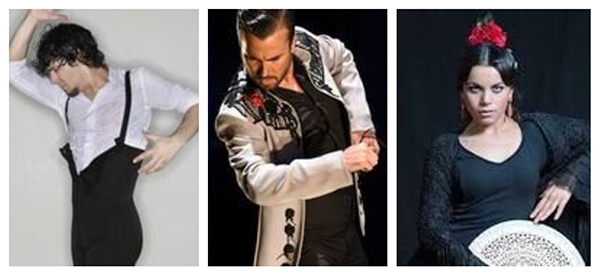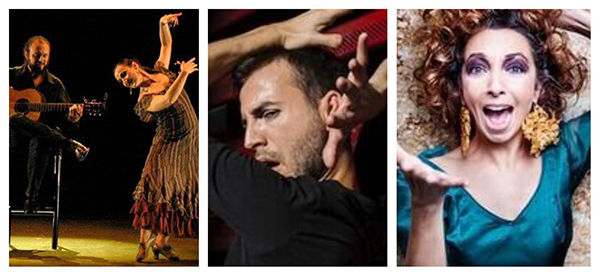30 Years of Presenting World Class Flamenco
BY EMMALY WIEDERHOLT
Eva Encinias Sandoval is the founder and artistic director of the Festival Flamenco Internacional de Alburquerque, an annual flamenco festival that takes place in Albuquerque, New Mexico. Now in its 30th year, Eva waxes about how the art form has evolved over the past three decades, and the unique appreciation among New Mexico audiences.
~~
How did the festival get started?
I had been teaching at the University of New Mexico for some time, since 1976. I had been realizing the importance for students to have access to other flamenco artists other than myself. There were two or three artists locally, but I wanted them to have access to more. This idea was in the back of my mind for several years. Then the College of Fine Arts at UNM asked me to put together a special performance to celebrate the 50th anniversary of the college. They gave me a small budget, and I saw it as a catalyst for me to invite artists from around the country to come perform. It ended up being one performance and two days of workshops. It was received beautifully. This was in 1987. From there, the college asked if I would consider making it an annual event. Little did they know I already had that in mind.
The festival has continued uninterrupted since then except for 2009 because the economic downfall made it difficult to pull it off financially. We suspended it that one year, and got back to it in 2010.
The festival has since become a destination for people all over the country and world.
Why do you think it’s important to place the festival in Albuquerque?
As a very young girl, I had the opportunity to travel to Spain and see beautiful flamenco artists. Even from a young age, I thought: Why don’t we have this in Albuquerque? When I had the opportunity to bring flamenco artists to Albuquerque through UNM, I wanted to see how far I could take it. How would it be received? I wasn’t sure. In so many states in the West and Southwest, the Hispanic heritage is much more in tune with the Mexican heritage than with the Spanish heritage. A lot of that has to do with bordering Mexico, but I think it also has to do with the Spanish culture not being as understood. One of the things that was most exciting for me was how the audiences in New Mexico responded to the festival. There’s something about the way they connect to flamenco. Even the touring artists from Spain have commented that the audiences see the form on a different level. They don’t just see it as entertainment; they understand the ritualistic process involved in flamenco. They really respect and honor the art form. For that reason, I’ve wanted to continue to nurture flamenco in New Mexico because I think it’s a natural manifestation of the preexisting culture.
From your perspective, how has flamenco evolved over the past 30 years?
As long as I have been in the flamenco world, there have always been various options as to how it’s presented. It can go from the very traditional tablao, solo-dancer, intimate performance to more theatrical productions. When we started the festival, there was the theatrical side, but it was not nearly as developed as it is now. Flamenco has become a world phenomenon, and the production aspect of it has really grown as a result. Theatricality is very much the way flamenco is seen in festivals and theaters around the world now. That doesn’t mean the more intimate and traditional settings are gone, but there are more theatrical productions available, and in very beautiful and dramatic ways.
What exchange goes on between the guest artists during the festival?
The artists who come are all fantastic professionals, but they don’t necessarily get many opportunities to spend time with each other. Everybody is usually off doing their own work. I think one of the things they love about coming to Albuquerque for the festival is that, while they are here, they are together the whole time.
The flamenco world is a relatively small place, and the artists all know of each other or are friends. But the opportunity and luxury to be with each other for 10 days is wonderful. They get to share their artistic ideas, exchange philosophies, touch base, be aware of what the others are doing, etc. I believe it is very stimulating for them. It’s something unique to our festival; all the artists are together all day long teaching and taking workshops, and then they all go to the theater to see a performance, and then go to a late-night tablao afterward. It’s an infusion of community. These artists spend most of their time in studios rehearsing, and the rest of their time lining up work. They don’t have a lot of time when they can just share ideas and connect.
How have you fostered appreciation for flamenco among audiences who may not have previously been familiar with the form?
As soon as New Mexican audiences started to see the art form in its fullness and wholeness — meaning guitarists, singers and dancers all working together — they just got it. I don’t think it was something that evolved. Now that’s not to say their appreciation hasn’t increased and that they haven’t become more sophisticated in understanding what they’re seeing. But with regards to appreciating, respecting and honoring flamenco as a profound form of expression, New Mexico audiences got that right away.
This has been verified for me by many of the guest artists. There’s something particular about the way people in New Mexico receive this art form. I think a lot of it is because New Mexicans come from ancient cultures — the Native Americans have been here for thousands of years, and the Spaniards have been here for hundreds. Tradition, heritage, the process of handing down art from generation to generation — these are all things New Mexicans live in and see all the time.
Looking toward the future, how do you see flamenco continuing to evolve?
I’m old enough that I’ve seen the art form go through cycles in my lifetime. I imagine that it’s going to go back to individual artists who are more focused on the spontaneous, improvisational process. At the same time, I think the theatrical process will also continue to grow; it’s such a healthy blending of influences, artistic ideas and cultures. But at the same time, in a parallel way, the individual artist will continue to explore more improvisational and intimate settings.
~~
Eva Encinias Sandoval is the founder and director of the National Institute of Flamenco as well as founder and professor of the Flamenco Dance emphasis program at the University of New Mexico. In 1982, Eva established the National Institute of Flamenco and, in 1987, the Festival Flamenco Internacional de Alburquerque. She originally learned flamenco from her mother, and now her own children practice the art form as well.
This year’s Festival Flamenco Internacional de Alburquerque runs June 10-17. Visit ffi30.org for more information.



2 Responses to “30 Years of Presenting World Class Flamenco”
Thanks for sharing Claire! She was a treat to interview, and it must have been a treat to experience such flamenco-greats back in the day!
Thanks for this piece on Eva Encinias. Takes me back to classes with her at UNM in the mid-80’s. There was a great exhibit last year of the Maria Benitez Flamenco Company, Santa Fe, at the Folk Art Musuem featuring the Romero brothers–dancer and musicians. Vicente, dancer, had partnered with Maria. Vicente is known for his all-night Flamenco jam sessions at his house. CR
Comments are closed.